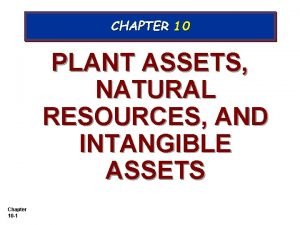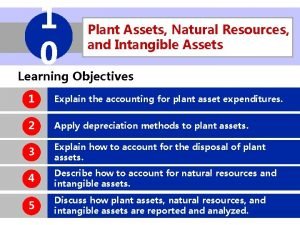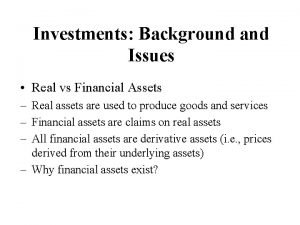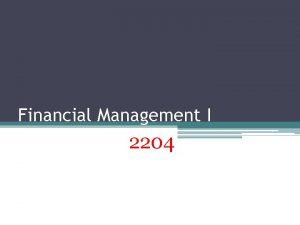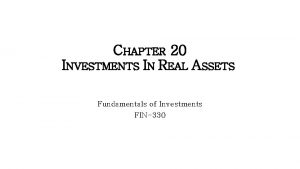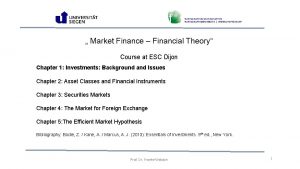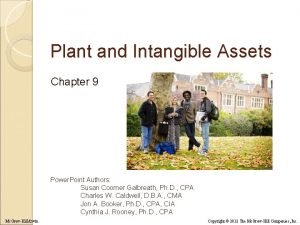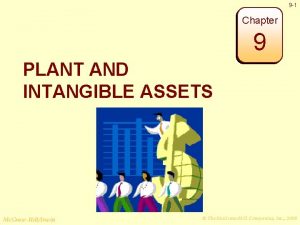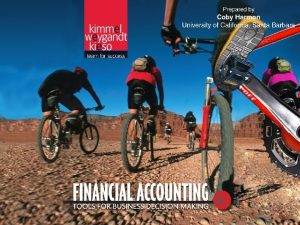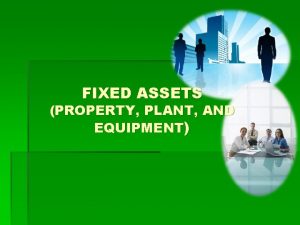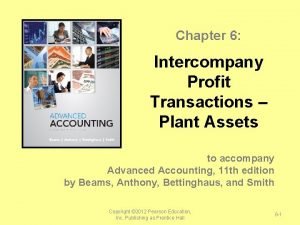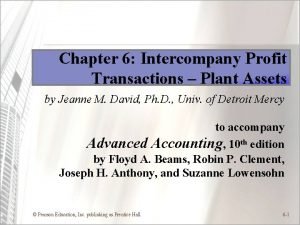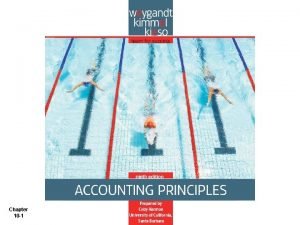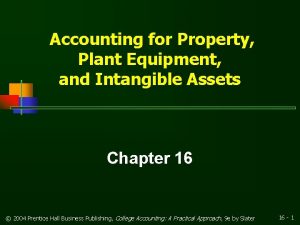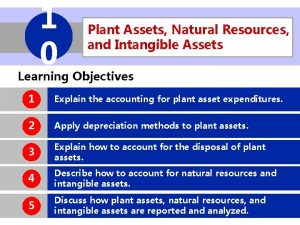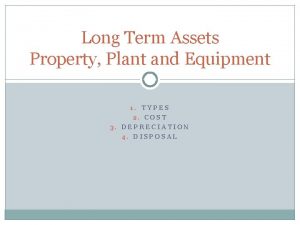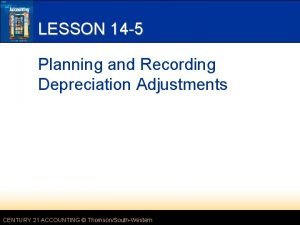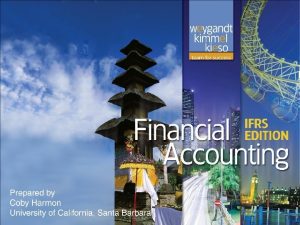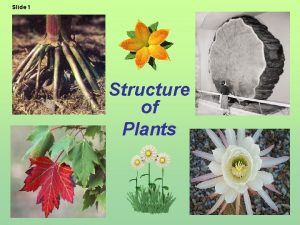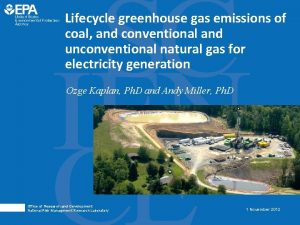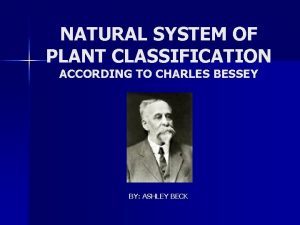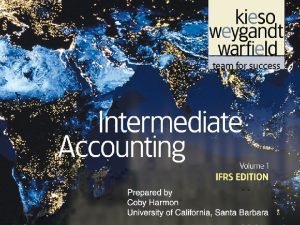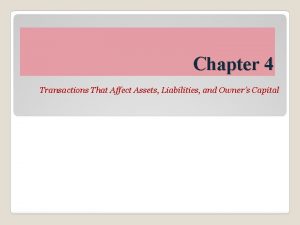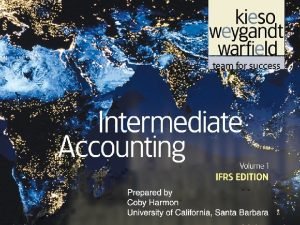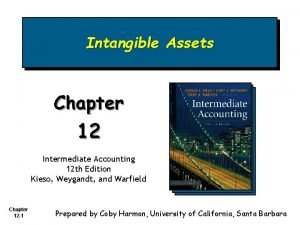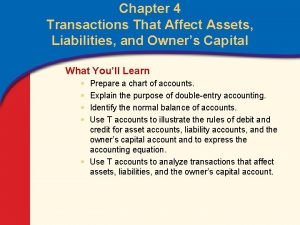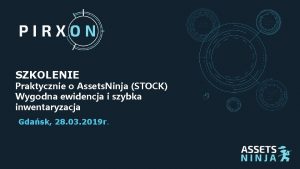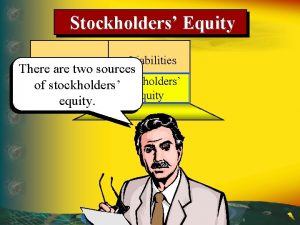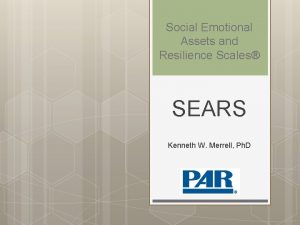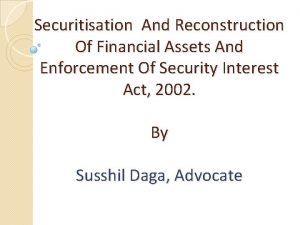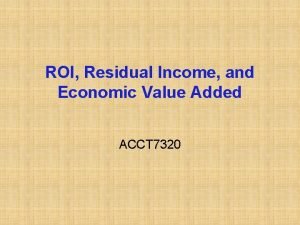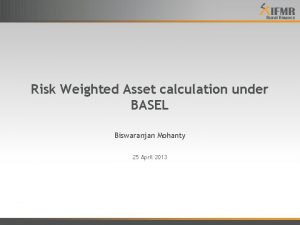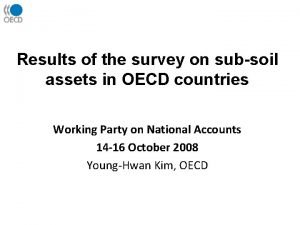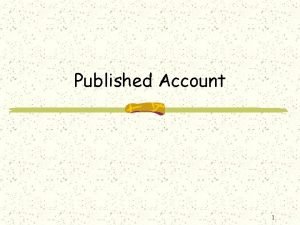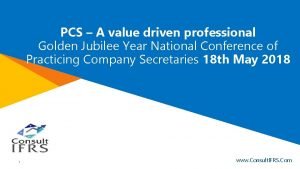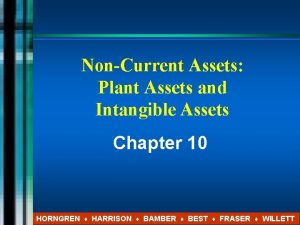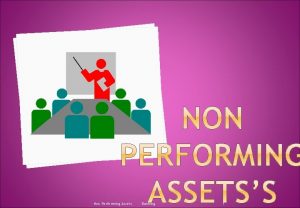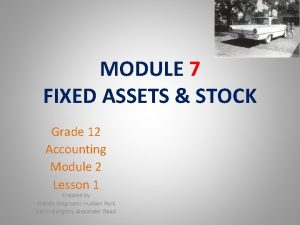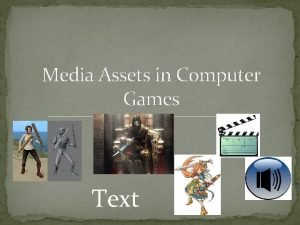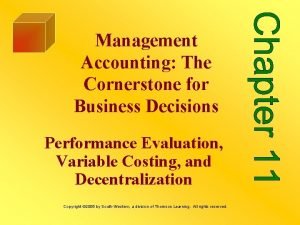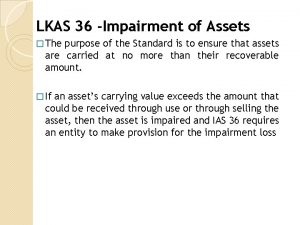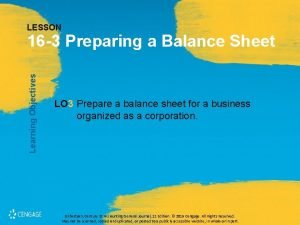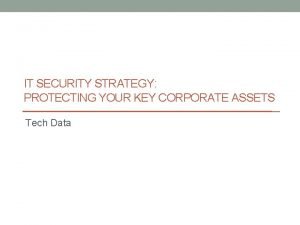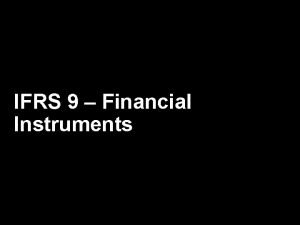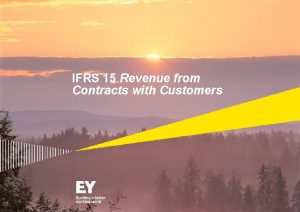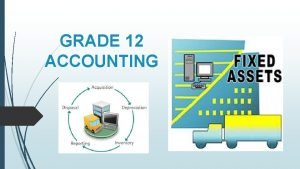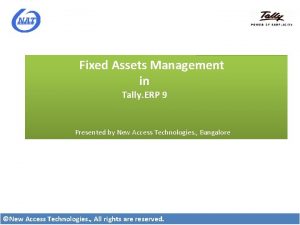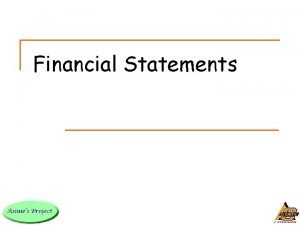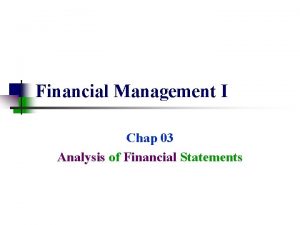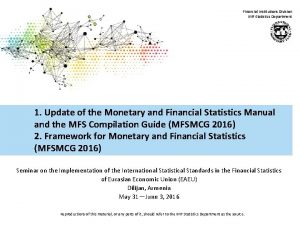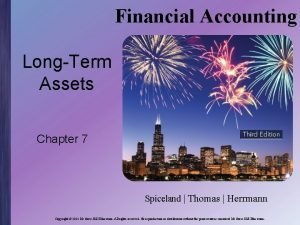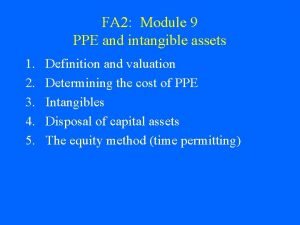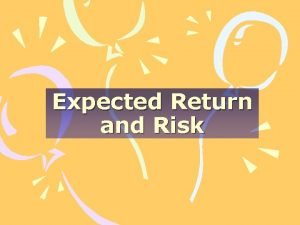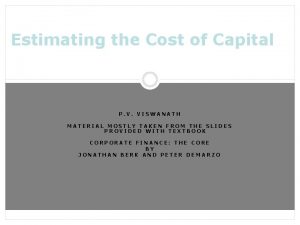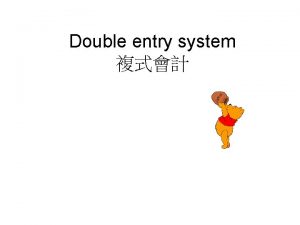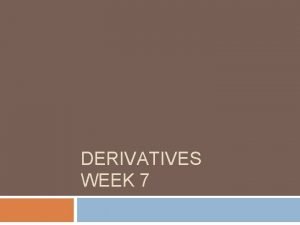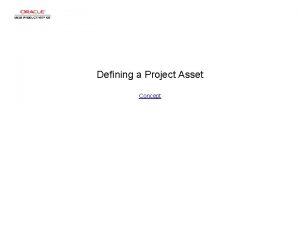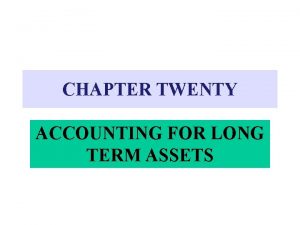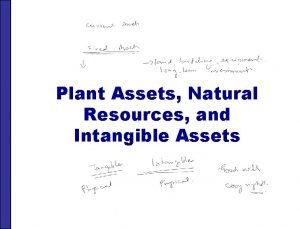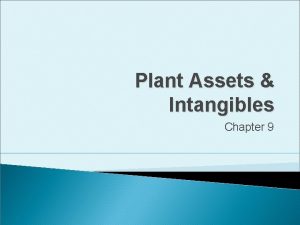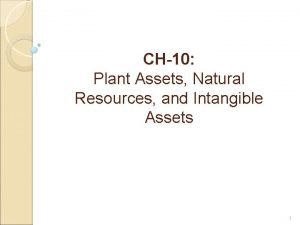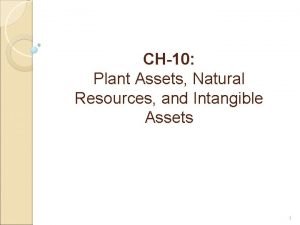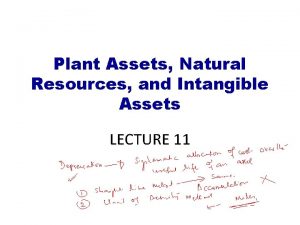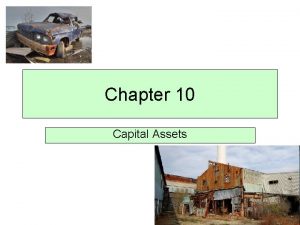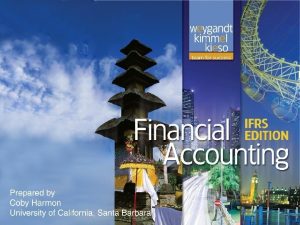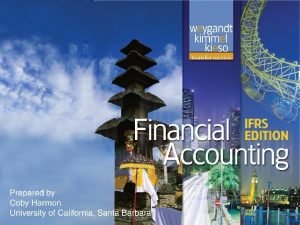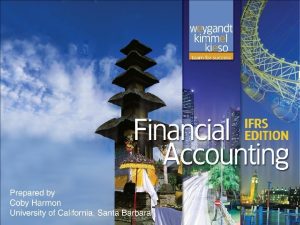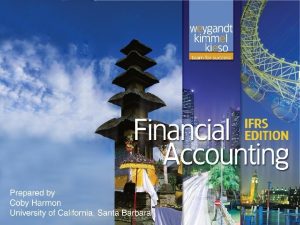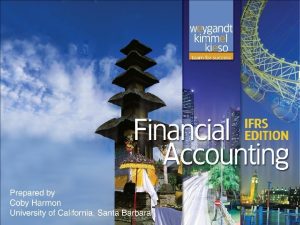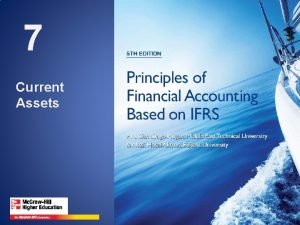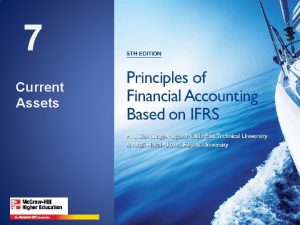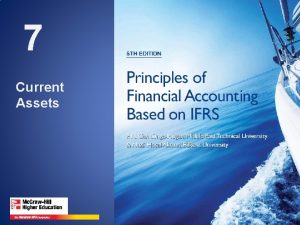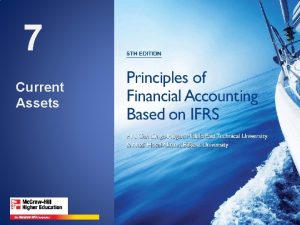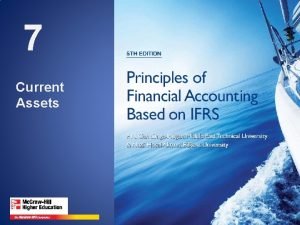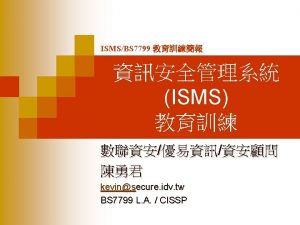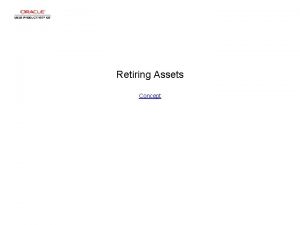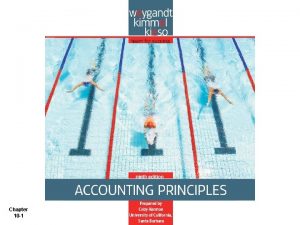Slide 9 1 Chapter 9 Plant Assets Natural









































































- Slides: 73

Slide 9 -1

Chapter 9 Plant Assets, Natural Resources, and Intangible Assets Financial Accounting, IFRS Edition Weygandt Kimmel Kieso Slide 9 -2

Study Objectives Slide 9 -3 1. Describe how the cost principle applies to plant assets. 2. Explain the concept of depreciation. 3. Compute periodic depreciation using different methods. 4. Describe the procedure for revising periodic depreciation. 5. Distinguish between revenue and capital expenditures, and explain the entries for each. 6. Explain how to account for the disposal of a plant asset. 7. Compute periodic depletion of extractable natural resources. 8. Explain the basic issues related to accounting for intangible assets. 9. Indicate how plant assets, natural resources, and intangible assets are reported.

Plant Assets, Natural Resources, and Intangible Assets Plant Assets Determining the cost of plant assets Depreciation Revaluation of plant assets Expenditures during useful life Plant asset disposals Slide 9 -4 Natural Resources Accounting for extractable natural resources Financial statement presentation Intangible Assets Accounting for intangibles Types of intangibles Research and development costs Statement Presentation and Analysis Presentation Analysis

Section 1 – Plant Assets Plant assets (Aset Tetap) meliputi tanah, pengembangan tanah, bangunan dan peralatan (mesin, perabot, peralatan). Karakteristik utama : q “digunakan dalam operasi” dan tidak untuk dijual kembali. q Sifatnya jangka panjang dan biasanya didepresiasikan q Memiliki substansi fisik. Referred to as property, plant, and equipment; plant and equipment; and fixed assets. Slide 9 -5

Section 1 – Plant Assets Illustration 9 -1 Percentages of plant assets in relation to total assets Slide 9 -6

Determining the Cost of Plant Assets Land ( Tanah) Meliputi seluruh biaya untuk mendapatkan tanah dan sampai tanah tersebut siap untuk digunakan : • Harga beli • Biaya penutupan, seperti fee pengacara • Komisi broker real estate • Biaya meratakan tanah, pengisian, pengeringan dan pembersihan • Assumsi hak gadai, hipotek, atau sitaan atas property. Slide 9 -7 SO 1 Describe how the cost principle applies to plant assets.

Determining the Cost of Plant Assets Illustration: Asumsi Hayes Manufacturing Company mengakuisisi real estate secara tunai sebesar $100, 000. Property ini terdiri dari gudang tua yang diratakan dengan biaya bersih sebesar $6, 000 (biaya sebesar $7, 500 dikurangi $1, 500 hasil sisa material). Pengeluaran tambahan yaitu fee pengacara $1, 000, dan komisi broker real estate sebesar $8, 000. Harga perolehan tanah sebesar $115, 000, dihitung sebagai berikut: Required: Tentukan jumlah yang dilaporkan sebagai harga perolehan tanah. Slide 9 -8 SO 1 Describe how the cost principle applies to plant assets.

Determining the Cost of Plant Assets Required: Determine amount to be reported as the cost of the land. Land Harga tunai properti of $100, 000 Biaya pemindahan dari gudang of $6, 000 Fee pengacara of $1, 000 Komisi broker Real estate of $8, 000 Cost of Land $115, 000 Journal Entry Land Cash Slide 9 -9 115, 000 SO 1 Describe how the cost principle applies to plant assets.

Determining the Cost of Plant Assets Land Improvements Semua pengeluaran yang diperlukan untuk membuat pengembangan dan siap untuk pengunaan yang dimaksudkan Jalan masuk, tempat parkir, pagar, lansekap, dan penyiram bawah tanah. Umur ekonomis terbatas. Beban (depresiasi) biaya pengembangan tanah selama masa manfaat. Slide 9 -10 SO 1 Describe how the cost principle applies to plant assets.

Determining the Cost of Plant Assets Buildings Seluruh biaya yang berhubungan langsung dengan pembelian atau konstruksi Biaya pembelian: • Harga pembelian, • biaya penutupan dan komisi broker real estate. • Renovasi dan penggantian atau perbaikan atap, lantai, kabel listrik, dan pipa. Biaya konstruksi: • Harga kontrak ditambah pembayaran untuk fee arsitek, izin bangunan dan biaya penggalian. Slide 9 -11 SO 1 Describe how the cost principle applies to plant assets.

Determining the Cost of Plant Assets Equipment Seluruh biaya yang terjadi untuk memperoleh peralatan dan membuatnya siap untuk penggunaan yang dimaksudkan. Costs typically include: Harga pembelian, Pajak penjualan, Biaya pengiriman dan penanganan, Asuransi peralatan selama transit, Biaya perakitan dan instalasi, dan Biaya pelaksanaan uji coba. Slide 9 -12 SO 1 Describe how the cost principle applies to plant assets.

Determining the Cost of Plant Assets Illustration: Assume Merten Company purchases factory machinery at a cash price of $50, 000. Related expenditures are for sales taxes $3, 000, insurance during shipping $500, and installation and testing $1, 000. Determine amount to be reported as the cost of the machinery. Machinery $50, 000 Cash price 3, 000 Sales taxes Insurance during shipping Installation and testing Cost of Machinery Slide 9 -13 500 1, 000 $54, 500 SO 1 Describe how the cost principle applies to plant assets.

Depreciation adalah proses pengalokasian harga perolehan aset berwujud menjadi beban dalam cara yang sistematik dan rasional pada periode yang telah diperkirakan dari manfaat sampai dengan penggunaan aset Process of cost allocation, not asset valuation. Applies to land improvements, buildings, and equipment, not land. Dapat didepresiasikan, karena kemampuan menghasilkan pendapatan dari aset akan menurun selama masa ekonomis aset. Slide 9 -14 SO 2 Explain the concept of depreciation.

Depreciation Factors in Computing Depreciation Illustration 9 -6 Cost Slide 9 -15 Useful Life Residual Value SO 2 Explain the concept of depreciation.

Depreciation Methods Tujuannya untuk memilih metode terbaik yang mengukur kontribusi aset ke pendapatan selama umur ekomomis. Examples include: (1) Straight-line method. (2) Units-of-Activity method. (3) Declining-balance method. Slide 9 -16 SO 3 Compute periodic depreciation using different methods.

Depreciation Illustration: Barb’s Florists purchased a small delivery truck on January 1, 2011. Illustration 9 -7 Required: Compute depreciation using the following. (a) Straight-Line Slide 9 -17 (b) Units-of-Activity (c) Declining Balance. SO 3 Compute periodic depreciation using different methods.

Depreciation Straight-Line Beban jumlahnya sama setiap tahun. Biaya yang dapat didepresiasikan (depreciable cost): harga perolehan (Cost) dikurangi nilai residunya (residual value) Illustration 9 -8 Slide 9 -18 SO 3 Compute periodic depreciation using different methods.

Depreciation Illustration: (Straight-Line Method) Illustration 9 -9 2011 $ 12, 000 2012 12, 000 2013 $ 2, 400 $ 10, 600 20 2, 400 4, 800 8, 200 12, 000 20 2, 400 7, 200 5, 800 2014 12, 000 20 2, 400 9, 600 3, 400 2015 12, 000 20 2, 400 12, 000 1, 000 2011 Journal Entry Slide 9 -19 20% Depreciation expense Accumulated depreciation 2, 400 SO 3 Compute periodic depreciation using different methods.

Depreciation Units-of-Activity Companies estimate total units of activity to calculate depreciation cost per unit. Expense varies based on units of activity. Depreciable cost is cost less residual Slide 9 -20 Illustration 9 -10 value. SO 3 Compute periodic depreciation using different methods.

Depreciation Illustration: (Units-of-Activity Method) Illustration 9 -11 2011 15, 000 $ 0. 12 $ 1, 800 $ 11, 200 2012 30, 000 0. 12 3, 600 5, 400 7, 600 2013 20, 000 0. 12 2, 400 7, 800 5, 200 2014 25, 000 0. 12 3, 000 10, 800 2, 200 2015 10, 000 0. 12 1, 200 12, 000 1, 000 2011 Journal Entry Slide 9 -21 Depreciation expense Accumulated depreciation 1, 800 SO 3 Compute periodic depreciation using different methods.

Depreciation Declining-Balance Decreasing annual depreciation expense over the asset’s useful life. Declining-balance rate is double the straight-line rate. Rate applied to book value. Illustration 9 -12 Slide 9 -22 SO 3 Compute periodic depreciation using different methods.

Depreciation Illustration: (Declining-Balance Method) Illustration 9 -13 2011 13, 000 40% $ 5, 200 $ 7, 800 2012 7, 800 40 3, 120 8, 320 4, 680 2013 4, 680 40 1, 872 10, 192 2, 808 2014 2, 808 40 1, 123 11, 315 1, 685 2015 1, 685 40 12, 000 1, 000 2011 Journal Entry Slide 9 -23 685* Depreciation expense 5, 200 Accumulated depreciation * Computation of $674 ($1, 685 x 40%) is adjusted to $685. 5, 200

Depreciation Comparison of Methods Illustration 9 -14 Illustration 9 -15 Slide 9 -24 SO 3 Compute periodic depreciation using different methods.

Depreciation Review Question Depreciation is a process of: a. valuation. b. cost allocation. c. cash accumulation. d. appraisal. Slide 9 -25 SO 3 Compute periodic depreciation using different methods.

Depreciation for Partial Year The following four slides are included to illustrate the calculation of partial-year depreciation expense. The amounts are consistent with the previous slides illustrating the calculation of depreciation expense. Slide 9 -26 SO 3 Compute periodic depreciation using different methods.

Depreciation for Partial Year Illustration: Barb’s Florists purchased a small delivery truck on October 1, 2011. Illustration 9 -7 Required: Compute depreciation using the following. (a) Straight-Line Slide 9 -27 (b) Units-of-Activity (c) Declining Balance. SO 3 Compute periodic depreciation using different methods.

Depreciation for Partial Year Illustration: (Straight-line Method) Slide 9 -28 SO 3 Compute periodic depreciation using different methods.

Depreciation for Partial Year Illustration: (Units-of-Activity Method) 2011 15, 000 $ 0. 12 $ 1, 800 $ 11, 200 2012 30, 000 0. 12 3, 600 5, 400 7, 600 2013 20, 000 0. 12 2, 400 7, 800 5, 200 2014 25, 000 0. 12 3, 000 10, 800 2, 200 2015 10, 000 0. 12 1, 200 12, 000 1, 000 2011 Journal Entry Slide 9 -29 Illustration 9 -12 Depreciation expense Accumulated depreciation 1, 800 SO 3 Compute periodic depreciation using different methods.

Depreciation for Partial Year Illustration: (Declining-Balance Method) Slide 9 -30 SO 3 Compute periodic depreciation using different methods.

Depreciation and Income Taxes Tax laws often do not require the taxpayer to use the same depreciation method on the tax return that is used in preparing financial statements. Many corporations use straight-line in their financial statements to maximize net income. At the same time, they use an accelerated-depreciation method on their tax returns to minimize their income taxes. Slide 9 -31 SO 3 Compute periodic depreciation using different methods.

Depreciation Revising Periodic Depreciation Accounted for in the period of change and future periods (Change in Estimate). Not handled retrospectively. Not considered error. Slide 9 -32 SO 4 Describe the procedure for revising periodic depreciation.

Depreciation Illustration: Assume that Barb’s Florists decides on January 1, 2014, to extend the useful life of the truck one year because of its excellent condition. The company has used the straight-line method to depreciate the asset to date, and book value is $5, 800 ($13, 000 - $7, 200). Questions: Slide 9 -33 1. What is the journal entry to correct the prior years’ depreciation? 2. Calculate the depreciation expense for 2014. No Entry Required SO 4 Describe the procedure for revising periodic depreciation.

Depreciation Book value, 1/1/14 Residual value Depreciable cost Useful life (revised) Annual depreciation First, establish Book Value at the date of change in estimate. $5, 800 - 1, 000 / 4, 800 3 years $ 1, 600 Illustration 9 -17 Journal entry for 2014 Depreciation expense Accumulated depreciation Slide 9 -34 1, 600 SO 4 Describe the procedure for revising periodic depreciation.

Depreciation Review Question When there is a change in estimated depreciation: a. previous depreciation should be corrected. b. current and future years’ depreciation should be revised. c. only future years’ depreciation should be revised. d. None of the above. Slide 9 -35 SO 4 Describe the procedure for revising periodic depreciation.

Revaluation of Plant Assets IFRS allows revaluation of plant assets to fair value If revaluation is used, it must be applied to all assets in a class of assets. Assets that are experiencing rapid price changes must be revalued on an annual basis, otherwise less frequent revaluation is acceptable. Slide 9 -36 SO 4 Describe the procedure for revising periodic depreciation.

Revaluation of Plant Assets Illustration: Pernice Company applies revaluation to plant assets with a carrying value of $1, 000, a useful life of 5 years, and no residual value. Pernice makes the following journal entries in year 1, assuming straight-line depreciation. Depreciation expense Accumulated depreciation 200, 000 After this entry, Pernice’s plant assets have a carrying amount of $800, 000 ($1, 000 - $200, 000). Slide 9 -37 SO 4 Describe the procedure for revising periodic depreciation.

Revaluation of Plant Assets Illustration: At the end of year 1, independent appraisers determine that the asset has a fair value of $850, 000. To report the plant assets at fair value, Pernice makes the following entry. Accumulated depreciation Plant assets Revaluation surplus 200, 000 150, 000 Revaluation surplus is an example of an item reported as other comprehensive income, as discussed in Chapter 5. Slide 9 -38 SO 4 Describe the procedure for revising periodic depreciation.

Revaluation of Plant Assets Pernice now reports the following information in its statement of financial position at the end of year 1. Illustration 9 -18 $850, 000 is the new basis of the asset. Pernice reports depreciation expense of $200, 000 in the income statement and $50, 000 in other comprehensive income. Depreciation in year 2 will be $212, 500 ($850, 000 / 4). Slide 9 -39 SO 4 Describe the procedure for revising periodic depreciation.

Expenditures During Useful Life Ordinary Repairs - expenditures to maintain the operating efficiency and productive life of the unit. Debit - Repair (or Maintenance) Expense. Referred to as revenue expenditures. Additions and Improvements - costs incurred to increase the operating efficiency, productive capacity, or useful life of a plant asset. Debit - the plant asset affected. Referred to as capital expenditures. Slide 9 -40 SO 5 Distinguish between revenue and capital expenditures, and explain the entries for each.

Plant Asset Disposals Companies dispose of plant assets in three ways — Retirement, Sale, or Exchange (appendix). Illustration 9 -19 Record depreciation up to the date of disposal. Eliminate asset by (1) debiting Accumulated Depreciation, and (2) crediting the asset account. Slide 9 -41 SO 6 Explain how to account for the disposal of a plant asset.

Plant Asset Disposals - Retirement of Plant Assets Illustration: Assume that Hobart Enterprises retires its computer printers, which cost $32, 000. The accumulated depreciation on these printers is $32, 000. The journal entry to record this retirement is: Accumulated depreciation Printing equipment 32, 000 Question: What happens if a fully depreciated plant asset is still useful to the company? Slide 9 -42 SO 6 Explain how to account for the disposal of a plant asset.

Plant Asset Disposals - Retirement Illustration: Assume that Sunset Company discards delivery equipment that cost $18, 000 and has accumulated depreciation of $14, 000. The journal entry is: Accumulated depreciation Loss on disposal Delivery equipment 14, 000 18, 000 Companies report a loss on disposal in the “Other income and expense” section of the income statement. Slide 9 -43 SO 6 Explain how to account for the disposal of a plant asset.

Plant Asset Disposals Sale of Plant Assets Compare the book value of the asset with the proceeds received from the sale. If proceeds exceed the book value, a gain on disposal occurs. If proceeds are less than the book value, a loss on disposal occurs. Slide 9 -44 SO 6 Explain how to account for the disposal of a plant asset.

Plant Asset Disposals - Sale Gain on Disposal Illustration: Assume that on July 1, 2011, Wright Company sells office furniture for $16, 000 cash. The office furniture originally cost $60, 000. As of January 1, 2011, it had accumulated depreciation of $41, 000. Depreciation for the first six months of 2011 is $8, 000. Prepare the journal entry to record depreciation expense up to the date of sale. Depreciation expense Accumulated depreciation Slide 9 -45 8, 000 SO 6 Explain how to account for the disposal of a plant asset.

Plant Asset Disposals - Sale Illustration 9 -20 Computation of gain on disposal Illustration: Wright records the sale as follows. July 1 Slide 9 -46 Cash 16, 000 Accumulated depreciation 49, 000 Office equipment 60, 000 Gain on disposal 5, 000 SO 6 Explain how to account for the disposal of a plant asset.

Plant Asset Disposals - Sale Loss on Disposal Illustration 9 -21 Computation of loss on disposal Illustration: Assume that instead of selling the office furniture for $16, 000, Wright sells it for $9, 000. July 1 Cash 9, 000 Accumulated depreciation 49, 000 Office equipment Loss on disposal Slide 9 -47 60, 000 5, 000 SO 6 Explain how to account for the disposal of a plant asset.

Section 2 – Natural Resources Natural resources consist of standing timber and resources extracted from the ground, such as oil, gas, and minerals. Standing timber is considered a biological asset under IFRS. In the years before they are harvested, the recorded value of biological assets is adjusted to fair value each period. Slide 9 -48 SO 7 Compute periodic depletion of extractable natural resources.

Section 2 – Natural Resources IFRS defines extractive industries as those businesses involved in finding and removing natural resources located in or near the earth’s crust. Cost - price needed to acquire the resource and prepare it for its intended use. Depletion - allocation of the cost to expense in a rational and systematic manner over the resource’s useful life. Depletion is to natural resources as depreciation is to plant assets. Companies generally use units-of-activity method. Depletion generally is a function of the units extracted. Slide 9 -49 SO 7 Compute periodic depletion of extractable natural resources.

Section 2 – Natural Resources Illustration: Assume that Lane Coal Company invests $5 million in a mine estimated to have 10 million tons of coal and no salvage value. In the first year, Lane extracts and sells 800, 000 tons of coal. Lane computes the depletion expense as follows: $5, 000 ÷ 10, 000 = $. 50 depletion cost per ton $. 50 x 800, 000 = $400, 000 depletion expense Journal entry: Depletion expense Accumulated depletion Slide 9 -50 400, 000 SO 7 Compute periodic depletion of extractable natural resources.

Financial Statement Presentation Illustration 9 -23 Statement presentation of accumulated depletion Extracted resources that have not been sold are reported as inventory in the current assets section. Slide 9 -51 SO 7 Compute periodic depletion of extractable natural resources.

Section 3 – Intangible Assets Intangible assets are rights, privileges, and competitive advantages that do not possess physical substance. Intangible assets are categorized as having either a limited life or an indefinite life. Common types of intangibles: Patents Copyrights Trademarks and trade names Franchises or licenses Goodwill IFRS permits revaluation of intangible assets to fair value, except for goodwill. Slide 9 -52 SO 8 Explain the basic issues related to accounting for intangible assets.

Types of Intangible Assets Patents Exclusive right to manufacture, sell, or otherwise control an invention for a specified number of years from the date of the grant. Legal life in many countries is 20 years. Capitalize costs of purchasing a patent and amortize over its legal life or its useful life, whichever is shorter. Legal fees incurred successfully defending a patent are capitalized to Patent account. Slide 9 -53 SO 8 Explain the basic issues related to accounting for intangible assets.

Accounting for Intangible Assets Intangible assets are typically amortized on a straight-line basis. Illustration: Assume that National Labs purchases a patent at a cost of $60, 000. National estimates the useful life of the patent to be eight years. National records the annual amortization as follows. Amortization expense Patent Slide 9 -54 7, 500 SO 8 Explain the basic issues related to accounting for intangible assets.

Accounting for Intangible Assets Copyrights Give the owner the exclusive right to reproduce and sell an artistic or published work. Ø plays, literary works, musical works, pictures, photographs, and video and audiovisual material. Granted for the life of the creator plus a specified number of years, which can vary by country but is commonly 70 years. Capitalize costs of acquiring and defending it. Amortized to expense over useful life. Slide 9 -55 SO 8 Explain the basic issues related to accounting for intangible assets.

Accounting for Intangible Assets Trademarks and Trade Names Word, phrase, jingle, or symbol that identifies a particular enterprise or product. Ø Wheaties, Game Boy, Frappuccino, Kleenex, Windows, Coca-Cola, and Jetta. Registration provides a specified number of years of protection, which can vary by country, but is commonly 20 years. Capitalize acquisition costs. Renewed indefinitely, no amortization. Slide 9 -56 SO 8 Explain the basic issues related to accounting for intangible assets.

Accounting for Intangible Assets Franchises and Licenses Contractual arrangement between a franchisor and a franchisee. Ø BP (GBR), Taco Bell (USA), or Rent-A-Wreck (USA) are franchises. Franchise (or license) with a limited life should be amortized to expense over the life of the franchise. Franchise with an indefinite life should be carried at cost and not amortized. Slide 9 -57 SO 8 Explain the basic issues related to accounting for intangible assets.

Accounting for Intangible Assets Goodwill Includes exceptional management, desirable location, good customer relations, skilled employees, high-quality products, etc. Only recorded when an entire business is purchased. Goodwill is recorded as the excess of. . . purchase price over the fair value of the identifiable net assets acquired. Internally created goodwill should not be capitalized. Slide 9 -58 SO 8 Explain the basic issues related to accounting for intangible assets.

Slide 9 -59 Answer on notes page

Research and Development Costs Frequently results in something that a company patents or copyrights such as: new product, process, formula, composition, or idea, literary work. Ø Costs in the research phase are always expensed as incurred. Ø Costs in the development phase are expensed until specific criteria are met, primarily that technological feasibility is achieved. Slide 9 -60 SO 8 Explain the basic issues related to accounting for intangible assets.

Statement Presentation and Analysis Presentation Slide 9 -61 Illustration 9 -24 SO 9 Indicate how plant assets, natural resources, and intangible assets are reported.

Statement Presentation and Analysis Illustration 9 -25 Each dollar invested in assets produced in sales. If a company is using its assets efficiently, each investment in assets will create a high amount of sales. Slide 9 -62 SO 9 Indicate how plant assets, natural resources, and intangible assets are reported.

Understanding U. S. GAAP Key Differences Plant Assets, Natural Resources, and Intangible Assets As in IFRS, under GAAP, the costs associated with research and development are segregated into the two components. Costs in the research phase are always expensed under both IFRS and GAAP. Under GAAP, however, costs in the development phase are also always expensed. As shown in this chapter, under IFRS, development costs can be capitalized once technological feasibility is achieved. IFRS permits revaluation of intangible assets (except for goodwill). GAAP prohibits revaluations of intangible assets. GAAP does not require component depreciation. Slide 9 -63

Understanding U. S. GAAP Key Differences Plant Assets, Natural Resources, and Intangible Assets GAAP does not permit the use of revaluation accounting for property, plant, and equipment, which is allowed under IFRS. Under both GAAP and IFRS, changes in the depreciation method used and changes in useful life are handled in current and future periods. Prior periods are not affected. GAAP recently conformed to IFRS in the accounting for changes in depreciation methods. Slide 9 -64

Understanding U. S. GAAP Key Differences Plant Assets, Natural Resources, and Intangible Assets IFRS allows reversal of impairment losses when there has been a change in economic conditions or in the expected use of the asset. Under GAAP, impairment losses cannot be reversed for assets to be held and used; the impairment loss results in a new cost basis for the asset. IFRS and GAAP are similar in the accounting for impairments of assets held for disposal. The accounting for exchanges of non-monetary assets has recently converged between IFRS and GAAP. Slide 9 -65

Understanding U. S. GAAP Looking to the Future Plant Assets, Natural Resources, and Intangible Assets It is too early to say whether a converged conceptual framework will recommend fair value measurement (and revaluation accounting) for plant assets and intangibles. However, this is likely to be one of the more contentious issues, given the long-standing use of historical cost as a measurement basis in GAAP. The IASB and FASB have identified a project that would consider expanded recognition of internally generated intangible assets. IFRS permits more recognition of intangibles compared to GAAP. Thus, it will be challenging to develop converged standards for intangible assets, given the long-standing prohibition on capitalizing internally generated intangible assets and research and development in GAAP. Slide 9 -66

Exchange of Plant Assets Appendix Ordinarily, companies record a gain or loss on the exchange of plant assets. The rationale for recognizing a gain or loss is that most exchanges have commercial substance. An exchange has commercial substance if the future cash flows change as a result of the exchange. Slide 9 -67 SO 10 Explain how to account for the exchange of plant assets.

Exchange of Plant Assets Illustration: Roland Co. exchanged old trucks (cost $64, 000 less $22, 000 accumulated depreciation) plus cash of $17, 000 for a new semi-truck. The old trucks had a fair value of $26, 000. Loss Treatment Slide 9 -68 Cost of old trucks Less: Accumulated depreciation Book value Fair value of old trucks Loss on disposal $64, 000 22, 000 42, 000 26, 000 $16, 000 Fair value of old trucks Cash paid Cost of new semi-truck $26, 000 17, 000 $43, 000 SO 10 Explain how to account for the exchange of plant assets.

Exchange of Plant Assets Illustration: Roland Co. exchanged old trucks (cost $64, 000 less $22, 000 accumulated depreciation) plus cash of $17, 000 for a new semi-truck. The old trucks had a fair market value of $26, 000. Prepare the entry to record the exchange of assets by Roland Co. Slide 9 -69 Semi-truck 43, 000 Accumulated depreciation 22, 000 Loss on disposal 16, 000 Used trucks 64, 000 Cash 17, 000 SO 10 Explain how to account for the exchange of plant assets.

Exchange of Plant Assets Illustration: Mark Express Delivery trades its old delivery equipment (cost $40, 000 less $28, 000 accumulated depreciation) for new delivery equipment. The old equipment had a fair value of $19, 000. Mark also paid $3, 000. Gain Treatment Slide 9 -70 Cost of old equipment Less: Accumulated depreciation Book value Fair value of old equipment Gain on disposal $40, 000 28, 000 12, 000 19, 000 $ 7, 000 Fair value of old equipment Cash paid Cost of new equipment $19, 000 3, 000 $22, 000 SO 10 Explain how to account for the exchange of plant assets.

Exchange of Plant Assets Illustration: Mark Express Delivery trades its old delivery equipment (cost $40, 000 less $28, 000 accumulated depreciation) for new delivery equipment. The old equipment had a fair value of $19, 000. Mark also paid $3, 000. Prepare the entry to record the exchange of assets by Mark Express. Delivery equipment (new) 22, 000 Accumulated depreciation 28, 000 Delivery equipment (used) Slide 9 -71 40, 000 Gain on disposal 7, 000 Cash 3, 000 SO 10 Explain how to account for the exchange of plant assets.

Exchange of Plant Assets Review Question In exchanges of assets in which the exchange has commercial substance: a. neither gains nor losses are recognized immediately. b. gains, but not losses, are recognized immediately. c. losses, but not gains, are recognized immediately. d. both gains and losses are recognized immediately. Slide 9 -72 SO 10 Explain how to account for the exchange of plant assets.

Copyright “Copyright © 2011 John Wiley & Sons, Inc. All rights reserved. Reproduction or translation of this work beyond that permitted in Section 117 of the 1976 United States Copyright Act without the express written permission of the copyright owner is unlawful. Request for further information should be addressed to the Permissions Department, John Wiley & Sons, Inc. The purchaser may make back-up copies for his/her own use only and not for distribution or resale. The Publisher assumes no responsibility for errors, omissions, or damages, caused by the use of these programs or from the use of the information contained herein. ” Slide 9 -73
 Natural asset companies
Natural asset companies Accumulated depreciation straight line method
Accumulated depreciation straight line method Plant assets, natural resources, and intangible assets
Plant assets, natural resources, and intangible assets Ano ang heel and toe polka
Ano ang heel and toe polka Financial assets and real assets
Financial assets and real assets Real assets vs financial assets
Real assets vs financial assets Types of real assets
Types of real assets Financial assets examples
Financial assets examples Plant and intangible assets chapter 9
Plant and intangible assets chapter 9 Plant and intangible assets chapter 9
Plant and intangible assets chapter 9 Format of indirect method of cash flow statement
Format of indirect method of cash flow statement Useful life of property plant and equipment
Useful life of property plant and equipment Intercompany profit transactions plant assets
Intercompany profit transactions plant assets Intercompany profit transactions plant assets
Intercompany profit transactions plant assets Fixed assets are ordinarily presented on the balance sheet
Fixed assets are ordinarily presented on the balance sheet Property, plant, and equipment and intangible assets are
Property, plant, and equipment and intangible assets are Units of activity method
Units of activity method Plant assets are used in operations
Plant assets are used in operations Recorded depreciation expense on the plant assets
Recorded depreciation expense on the plant assets Journal entry for revaluation of assets
Journal entry for revaluation of assets Slide divide method
Slide divide method Reproductive structure of a plant
Reproductive structure of a plant Scope of plant breeding
Scope of plant breeding Taichum
Taichum Plant introduction in plant breeding
Plant introduction in plant breeding Tronsmo plant pathology and plant diseases download
Tronsmo plant pathology and plant diseases download Tronsmo plant pathology and plant diseases download
Tronsmo plant pathology and plant diseases download Albugo eye
Albugo eye Greenhouse impact
Greenhouse impact Bessey system of classification
Bessey system of classification Examples of intangible asset
Examples of intangible asset Problem 4-1 applying the rules of debit and credit
Problem 4-1 applying the rules of debit and credit Impairment of intangible assets
Impairment of intangible assets Tangible examples
Tangible examples Chapter 4 transactions that affect assets
Chapter 4 transactions that affect assets Natural hazards vs natural disasters
Natural hazards vs natural disasters Natural income
Natural income Accounting income vs taxable income
Accounting income vs taxable income Stranded assets
Stranded assets Financial assets examples
Financial assets examples Great gatsby lessons
Great gatsby lessons Ninja stock
Ninja stock Assets = liabilities + stockholders' equity
Assets = liabilities + stockholders' equity Sears rating scale
Sears rating scale Securitisation and reconstruction of financial assets
Securitisation and reconstruction of financial assets Economic value added
Economic value added Risk weighted assets calculation
Risk weighted assets calculation Sub soil assets
Sub soil assets Non fixed assets examples
Non fixed assets examples Value driven professional
Value driven professional Current assets examples
Current assets examples Doubtful 1 assets
Doubtful 1 assets New era accounting grade 12 solutions pdf module 7
New era accounting grade 12 solutions pdf module 7 Text computer games
Text computer games How to calculate eva
How to calculate eva Lkas 36
Lkas 36 How does threegreen classify its assets?
How does threegreen classify its assets? Which of the following are key corporate assets?
Which of the following are key corporate assets? Financial assets ifrs
Financial assets ifrs 5 step model ifrs 15
5 step model ifrs 15 Fixed assets grade 12
Fixed assets grade 12 Fixed assets in tally
Fixed assets in tally Current assets examples
Current assets examples Fixed asset turnover ratio example
Fixed asset turnover ratio example Financial institutions division
Financial institutions division Franchise amortization
Franchise amortization 9ppe download
9ppe download Portfolio variance formula
Portfolio variance formula Unlevered return on assets
Unlevered return on assets Assets capital liabilities
Assets capital liabilities Derivatives week
Derivatives week Project assets meaning
Project assets meaning Other long term assets
Other long term assets Average collection period formula
Average collection period formula

